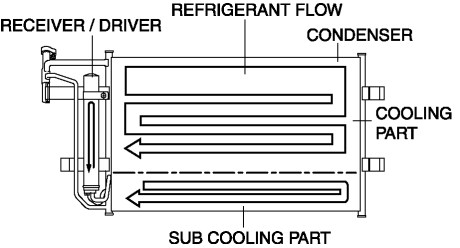Mazda CX-5 Service & Repair Manual: Condenser
Purpose
-
The condenser cools the high-temperature, highly pressurized refrigerant.
Function
-
The condenser cools the high-temperature, highly pressurized gaseous refrigerant compressed by the A/C compressor using the outside air, and changes it to liquid refrigerant.
Construction
-
The condenser is installed to the front of the radiator.
-
The condenser consists of the tube which passes refrigerant, and the heat radiation fin.

-
A sub-cooling condenser has been adopted.

-
The sub-cooling condenser is integrated with the multi-flow condenser and the receiver driver.
-
The sub-cooling condenser separates the refrigerant, cooled once by the condenser, into vapor and liquid using the receiver/drier, and by returning it to the sub-cooling part of the condenser again to cool.
-
As a result, liquefaction of the refrigerant is promoted and cooling performance is improved.
Operation
-
The high-temperature, highly pressurized gaseous refrigerant sent from the A/C compressor passes through the tube in the condenser.
-
When the air blown from the outside is exposed to the heat radiation fin, the heat of the refrigerant is captured by heat exchange, and the refrigerant changes from a gas to a liquid.
-
The liquid refrigerant is sent to the expansion valve via the receiver/drier.
Fail-safe
-
Function not equipped.
 Climate Control Unit [Manual Air Conditioner]
Climate Control Unit [Manual Air Conditioner]
Purpose
The climate control unit performs air conditioning according to the operation
by the users and the driving conditions of the vehicle.
Function
The climate control unit d ...
 Condenser Inspection
Condenser Inspection
1. Inspect the condenser for cracks, damage, and oil leakage.
If there is any malfunction, replace the condenser.
2. Visually inspect for bent fins for clogging of foreign material.
...
Other materials:
Engine Transaxle Integration Control [Fw6 A EL, Fw6 Ax EL]
Outline
The TCM controls engine output torque and reduces transaxle output shaft
torque fluctuation during auto shifting, and reduces shock occurring from the
vehicle during shifting.
Construction
Operation
During auto shifting, the TCM sends the torque reduction reque ...
Electrical Fan Control
Outline
Through cooling of the radiator and condenser by operation of the cooling
fan according to vehicle conditions, engine reliability and cooling performance
have been improved.
Block Diagram
Operation
The PCM determines the demand airflow volume by the following c ...
Spare Tire and Tool Storage
Spare tire and tools are stored in the locations illustrated in the diagram.
Except Mexico
Mexico
Jack
To remove the jack
1. Open the trunk board.
2. Secure the trunk board by attaching the hook to the head restraint.
Without luggage compartment cover
With luggage compartment cover
...
